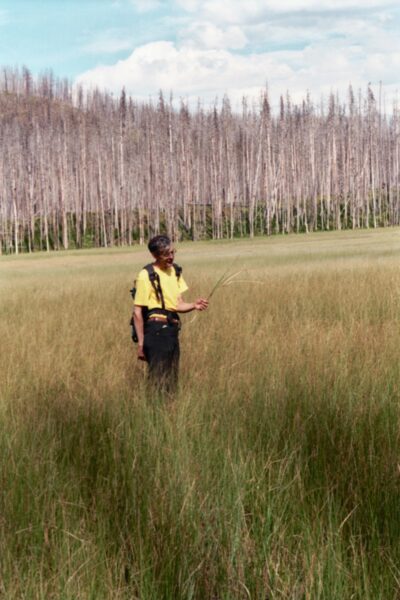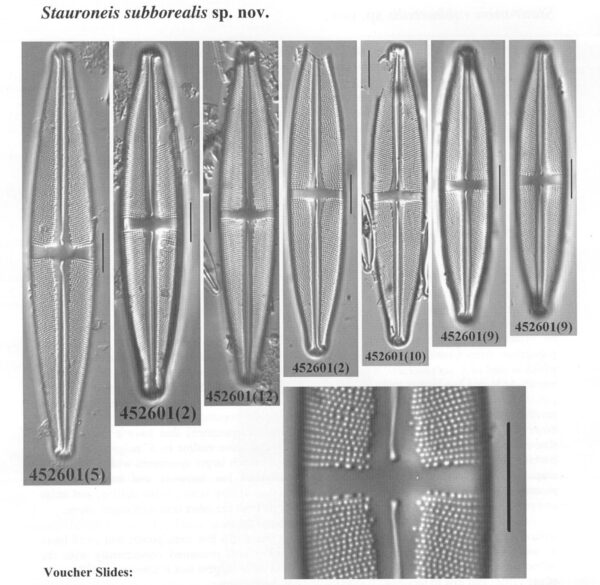Stauroneis subborealis
-
Category
-
Length Range46-142 µm
-
Width Range9-24 µm
-
Striae in 10 µm17-20
-
ContributorLoren Bahls - Dec 2011
-
ReviewerMark Edlund - Jun 2012
Identification
Description
Valves are linear in small specimens to lanceolate in larger specimens, with protracted and broadly rounded apices. The axial area is narrow and widens slightly near the central area. The stauros is narrow, somewhat expanded toward the valve margins, and occasionally contains short striae at the margins. Raphe branches are lateral. Proximal raphe ends are inflated and curved. Terminal raphe fissures are hooked. Striae are radiate throughout. Areolae number 18–22 in 10 µm.
Autecology
Stauroneis subborealis has been found in a few fens, ponds, and small lakes in western Montana. The pH of these waters ranges from 6.2 to 9.1 and specific conductance ranges from 10 to 257 µS/cm.
-
Size Range, µm3
-
Motility
-
Attachment
-
Habitat
-
Colony
-
Waterbody
- Learn more about this
Original Description
Valves are linear in small specimens to lanceolate in larger specimens, with protracted and broadly rounded apices. Length 46–142 µm, width 9–24 µm. Length to width ratio: 4.9-6.6. Axial area narrow, widening slightly near the central area. Transverse fascia narrow, somewhat expanded toward the valve margins, occasionally containing short striae. Raphe fissures lateral, proximal endings inflated and curved. Terminal raphe fissures hooked. Striae radiate throughout, 17–20 in 10 µm. Striae puncta 18–22 in 10 µm. For measurements, n = 31 valves.
-
AuthorBahls 2010
-
Length Range46-142 µm
-
Width9-24 µm
-
Striae in 10µm17-20
Citations & Links
Citations
Links
-
Index Nominum Algarum
Cite This Page
Bahls, L. (2011). Stauroneis subborealis. In Diatoms of North America. Retrieved April 25, 2024, from https://diatoms.org/species/stauroneis_subborealis
Responses
The 15 response plots show an environmental variable (x axis) against the relative abundance (y axis) of Stauroneis subborealis from all the stream reaches where it was present. Note that the relative abundance scale is the same on each plot. Explanation of each environmental variable and units are as follows:
ELEVATION = stream reach elevation (meters)
STRAHLER = distribution plot of the Strahler Stream Order
SLOPE = stream reach gradient (degrees)
W1_HALL = an index that is a measure of streamside (riparian) human activity that ranges from 0 - 10, with a value of 0 indicating of minimal disturbance to a value of 10 indicating severe disturbance.
PHSTVL = pH measured in a sealed syringe sample (pH units)
log_COND = log concentration of specific conductivity (µS/cm)
log_PTL = log concentration of total phosphorus (µg/L)
log_NO3 = log concentration of nitrate (µeq/L)
log_DOC = log concentration of dissolved organic carbon (mg/L)
log_SIO2 = log concentration of silicon (mg/L)
log_NA = log concentration of sodium (µeq/L)
log_HCO3 = log concentration of the bicarbonate ion (µeq/L)
EMBED = percent of the stream substrate that is embedded by sand and fine sediment
log_TURBIDITY = log of turbidity, a measure of cloudiness of water, in nephelometric turbidity units (NTU).
DISTOT = an index of total human disturbance in the watershed that ranges from 1 - 100, with a value of 0 indicating of minimal disturbance to a value of 100 indicating severe disturbance.

Stauroneis subborealis
- Valves linear in small specimens, lanceolate in large specimens
- Apices protracted and broadly rounded
- Proximal raphe ends curved, inflated
- Striae 17-20 in 10 µm
- Areolae 18-22 in 10 µm
The small specimens are linear, while large specimens are lanceolate; 46-142 µm in length. Apices are protracted and broadly rounded. Proximal raphe ends are curved and inflated. Striae are radiate throughout and number 17-20 in 10 µm. Areolae number 18-22 in 10 µm.
 Diatoms of North America
Diatoms of North America









